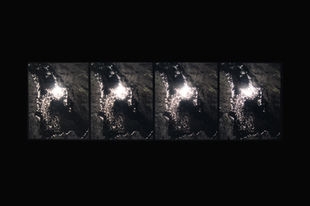SPHERE: Artists Residency & Photography Exhibition
Boojum & Snark, IoW (2021)
“Cameras, in short, were clocks for seeing…”
Roland Barthes, Camera Lucida
In 2019 the IOW was declared a UNESCO Biosphere reserve -an area of outstanding natural beauty where the ecosystem and the people who live alongside it are in harmony. In SPHERE I wanted to look at the often overlooked patterns, structures and complexities that make up the natural world, and our place entwined within it. I explored the landscape of Sandown Bay through different scales of time: from the fleeting to the ancient - the deep time of the night sky, geological layers, human history, natural cycles of seasons, growth and decay, to droplets captured mid air for a moment then gone.
The images use rhythm and repetition - through stereographic suspended movement or short zoetrope-style motion sequences - to play with time in different ways. I used antique analogue cameras. Bob Shaw has this concept of ’Slow Glass’ - that the light passing through holds memories, I think these cameras do too, ‘Eyes’ filtering light through time.
I also used filters made from real plants and waste materials when photographing and scanning, and ones from sea water. It is as if nature is telling its own story in layers of time and decay.
I use stereoscopic and early animation techniques (Eadweard Muybridge for example). They’re taken on different toy cameras and adapters, some work like a stereograph, freezing a moment and dancing around it in 3D space, the others do short sequential images over a few seconds, a kind of beggar’s or micro cinema on 35mm.
The Cabinet of Mundanities & Ephemeralities draws on the Victorian hobby of specimen collection (some of which, like seaweed collections, are used today to track changing biodiversity) and the Cabinet of Curiosities style museum. These were arranged to situate the western world at the pinnacle of human evolution. However I'm more interested in a cabinet that is participatory, hybrid, containing the overlooked and things that might be lost. So there is sand, grass, dirt, seawater and different kinds of plastic waste, as well as objects made by local participants. I made kits as socially distanced participation tools, so people could have a go at some of the techniques I use - from using living plants as slides or filters or drawing/painting on discarded celluloid to make micro cine animations.
All of these techniques portray the landscape as seen through multiple ‘eyes’/viewpoints: natural, historical, cultural, nonhuman, creating tiny windows through which to view the environment, the people who inhabit it, and interconnecting scales of time.
Find out more here.
Local press here























